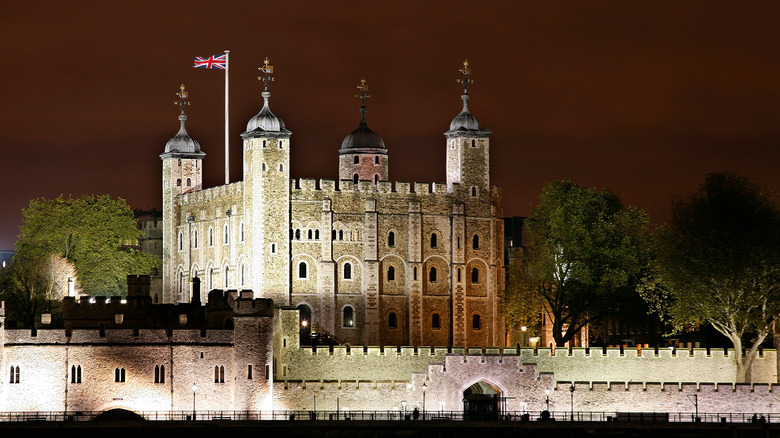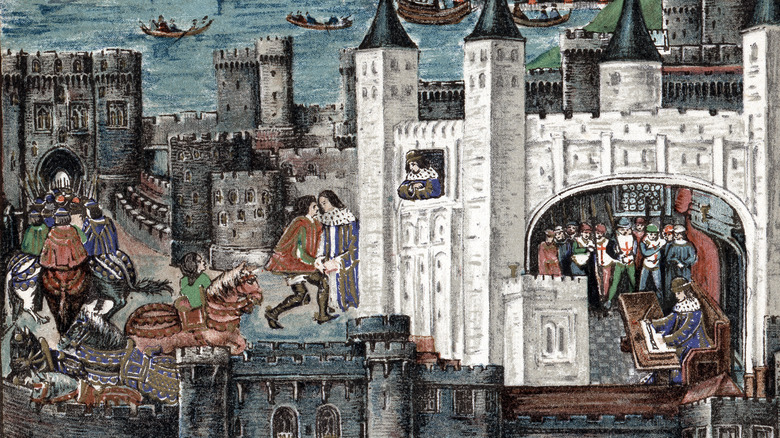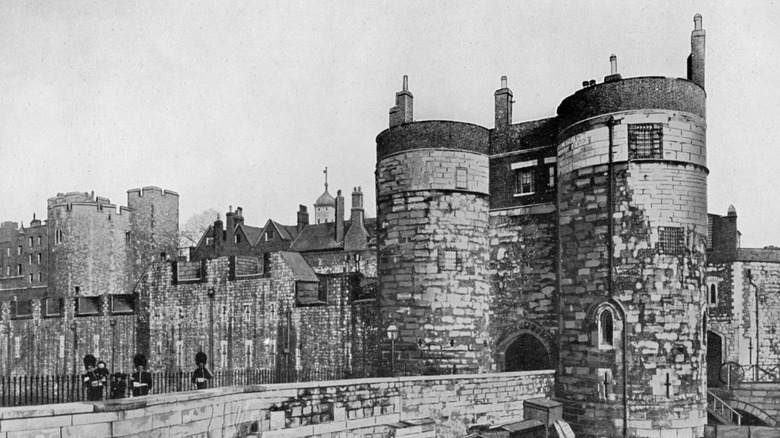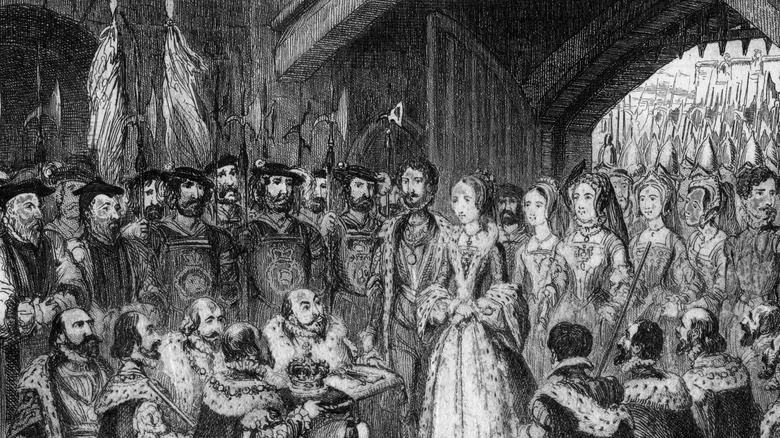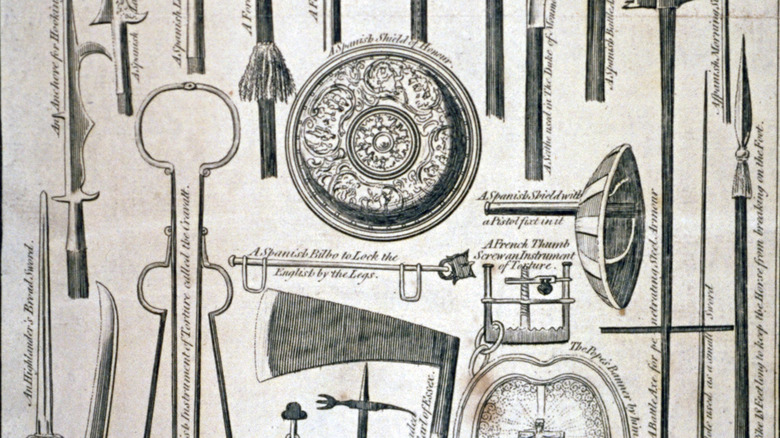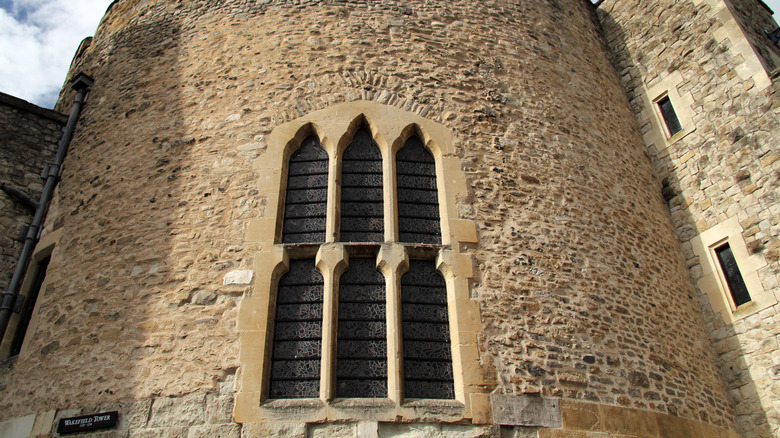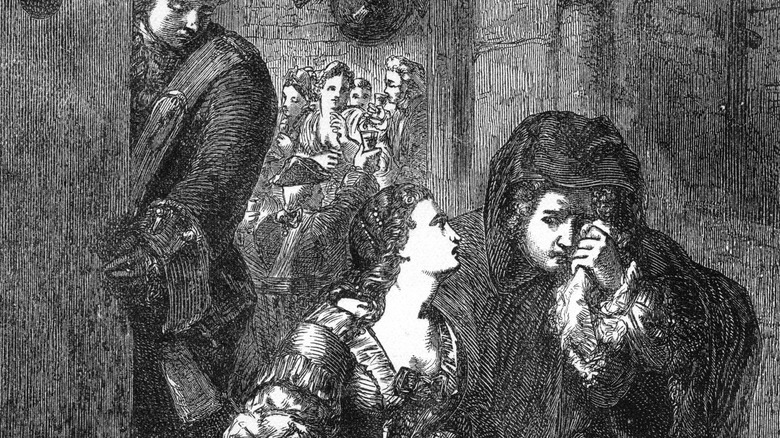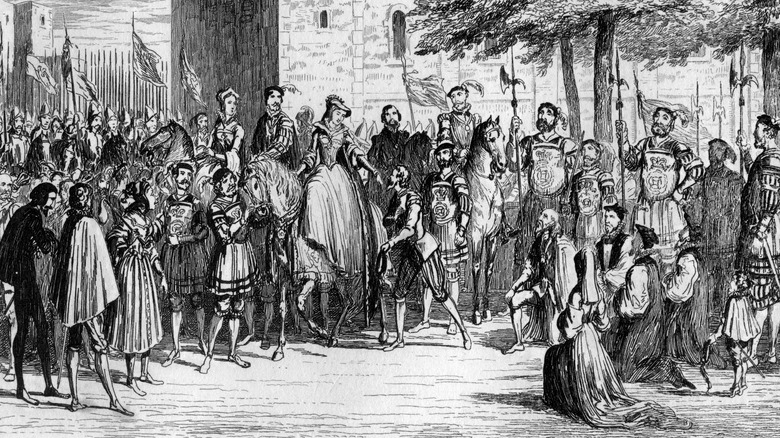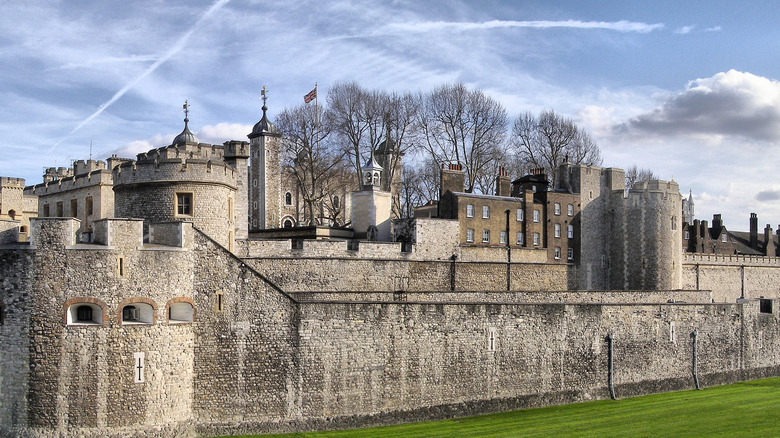Here's What It Was Like For Prisoners In The Tower Of London
The Tower of London is one of history's most famous prisons. It has become associated with images of deep dungeons, grisly torture, and public beheadings, but it also contained luxurious apartments for wealthy prisoners. Those imprisoned there included accused sorcerers, plotters against the crown, knights, lords, members of the clergy, and even the future Queen Elizabeth I.
The Tower is well known for the extreme violence that occurred there during the 16th and 17th centuries, but it was in use as a prison for more than 800 years. As noted by Historic Royal Palaces, experiences inside the Tower were extremely varied. The daily life of a prisoner held here was dependent on when they were imprisoned, the crime that they were accused of, and how much influence they had. Here's what it was like for prisoners in the Tower of London.
The following article includes descriptions of historical torture and death.
Time period and treatment of prisoners
The Tower of London served as a prison from the 12th century until the 1940s. Over almost 900 years, the types of prisoners in the Tower and how they were treated varied.
During the reign of Henry III (1216–1272), wealthy prisoners were required to pay for the privilege of being in the Tower on London. According to "Tower of London," annual fees for a "suite of his irons" were as much as £20 for a duke. According to the Bank of England's inflation calculator, this is the modern-day equivalent $40,400 per year. Prisoners were also frequently charged room and board.
In the 1400s, following the Battle of Agincourt, French prisoners were held indefinitely in exchange for large ransoms paid to the Crown. Many were unable to pay and the prisoners died in the tower.
The violent interrogations and public executions that the Tower is best known for took place primarily during the 16th and 17th century, which, as noted by Historic Royal Palaces, gained the site a bloody reputation.
By the Victorian era, macabre tourists started visiting the dungeons, thrilled by the idea of the torture and deaths that had occurred there. While prisoners were no longer tortured with thumbscrews or the dreaded rack, the Tower was not just a tourist attraction. The Cato Conspirators (who had planned an uprising that included seizing the Tower) were imprisoned there in the 1800s, as reported by the Royal Armouries.
The first prisoner and the last prisoners
The first prisoner recorded as serving time in the Tower of London was the Bishop of Durham. He was imprisoned in 1100 for misappropriating funds. According to Richard Nevell's "Castles as Prisons" the Bishop was "widely detested." Despite this, his rank granted him many advantages, including living in a comfortable room in the White Tower, receiving a stipend from the King for meals, and being allowed to keep servants.
Security on the Bishop was so lax that he was able to escape. His conspirators brought him wine with a rope hidden inside, which he used to shimmy out of a large window.
During World War II, Nazi prisoners were held in the Tower of London, including Rudolf Hess, the "deputy Führer of the Nazi party and Adolf Hitler's right-hand man." Unlike the Bishop of Durham, Hess was imprisoned under the tightest security possible.
Hess only passed through the Tower for a few days of questioning, and he spent the majority of his life sentence in Berlin, but German spy Josef Jakobs was brought to the Tower directly from interrogation by MI5 to await trial, and ultimately execution. Jakobs was in the UK spying for the Nazis, but he did so to gain his freedom from a concentration camp — he had been caught selling black market passports to Jews, allowing them to escape Germany. He was killed by firing squad in 1941, making him the last person to be executed at the Tower.
A stratified prison
As the Bishop of Durham's story shows, life as a prisoner in the Tower of London could be highly influenced by wealth. High-status prisoners were often kept in the luxury that they were used to, albeit unable to leave — though some were allowed out of the Tower for hunting trips.
Prisoners without the benefit of a title or money could expect a very different experience, including dangerous living conditions, disease, and the threat of starvation. Statesman John Elliot was the son of a wealthy landowner, but that didn't protect him from poor treatment. As stated in "Tower of London," Elliot was not allowed exercise, "apart from a few steps each day along the platform of a wall outside his cell door." He was not given candles, leaving his cell cold and dark. Within a few years he had developed tuberculosis and died in the Tower.
While their time in confinement was certainly preferable to being held in a dungeon, plenty of royal prisoners still met grisly fates at the Tower. As noted on the Tower's website, in 1533, before the coronation of Anne Boleyn, second wife of Henry VIII, he had the former royal palace in the Tower renovated for a celebratory feast. In 1536, he would have Boleyn sent to the Tower and imprisoned in the same extravagant apartments. No matter how comfortable her time in prison was, she was still executed on Tower Green.
Royal Prisoners
The Tower was frequently used to hold political prisoners, and that included both foreign and English royals. Earls, countesses, and lords were beheaded at the tower, and three English queens were executed at Tower Green.
While royal prisoners were often beheaded, others met stranger fates. Contemporary sources state that the Duke of Clarence was drowned in a barrel of wine. Edward IV's sons were murdered in the Tower in 1483. As noted by Historic Royal Palaces, bones believed to belong to the princes were discovered buried under the stairs of the White Tower.
The Tower was not always a death sentence for royal prisoners, however. In 1554, Elizabeth I, who was at that point a princess, was imprisoned in the Tower. She was held in the same apartments that her mother, Anne Boleyn, had been a prisoner before her execution. By 1559, though, she would not only be free, but crowned the Queen of England.
Common prisoners
Less is known about the treatment of common prisoners than influential ones, simply because they weren't often documented.
As reported by Trevor Floyd for Marin Theatre Company, even methods of execution were stratified. While the nobility were usually beheaded, commoners could expect a public hanging. Those who weren't hanged might be burned at the stake or drawn and quartered.
Without the benefit of luxurious royal apartments, poor prisoners were at serious risk of death from mistreatment or neglect in their cells. During the War of the Roses, an "impoverished Lancastrian knight" was kept in a dungeon without access to a fire, bed, or anything to eat. According to "Tower of London," he asked his guard if he would be willing to cook any food he was able to procure. Then he lured a cat that was loose in the Tower into his cell, but rather than eating the cat, he befriended it. Over time, the cat brought dead pigeons to his cell, which the guard cooked for the prisoner.
Heretics: religious prisoners
Religion has been a major cause of violence in England's history, particularly after Henry VIII broke with the Catholic church in order to marry Anne Boleyn, creating the Church of England. After the brief reign of Henry VIII's 9-year-old son Edward VI, Lady Jane Grey was set to take the throne with her husband, in order to bypass the Catholic Princess Mary. Grey was brought to the Tower ceremonially, but would end up spending the rest of her short life there. Her time as queen lasted just nine days before she relinquished the crown to Princess Mary, but was not allowed to leave the Tower.
According to "Tower of London," attempts were made to convert Grey to Catholicism while she was a prisoner, but she refused. Within a year she was executed. As queen, Mary was nicknamed Bloody Mary due to her attempts to convert England to Catholicism by force, including the burning of Protestant bishops.
Protestants and Catholics were not the only "heretics" imprisoned in the Tower, however. In Julia Karam's article for EF Educational Tours, in the 1500s, a man named Hew Draper was incarcerated on charges of sorcery. According to "Prisons and Prison Systems: A Global Encyclopedia," in the late 1200s, 600 Jewish people were sent to the Tower on trumped-up accusations of trimming coins down. About half of them were executed, and the rest died of poor treatment and neglect while imprisoned.
Treason: political prisoners
Technically, tampering with money, as the Jewish prisoners in the 1200s were charged with, was considered treason – and those imprisoned for treason often received the harshest treatment. The most famous example is probably the Gunpowder Plot.
Under the rule of Protestant James I, Catholic convert Guy Fawkes and a group of conspirators made a plan to blow up the House of Lords. According to "Tower of London," they were on track for success until they attempted to warn Catholic supporters not to go to Parliament on the day of their plan, November 5, 1605. Fawkes was caught in a cellar under Parliament with barrels of gunpowder, and taken to the Tower for questioning.
On November 6, James I authorized the use of torture to get a confession from Fawkes. The order, as quoted on the UK Parliament website, recommended the use of "the gentler tortours," however Fawkes's signature on a confession given November 8 is a nearly illegible scrawl, showing the terrible condition he was in after only two days.
One of the conspirators died while being held in the Tower, but the others, including Fawkes, were sentenced to death.
Gossip, romance, and personal grudges
Many people held in the Tower were former favorites of the Crown, like Anne Boleyn. Thomas Overbury was an advisor to one of King James I's favorites, Robert Carr. As stated in "The Fall of Sir Thomas Overbury and the Embassy to Russia in 1613," "when Carr became King James' favorite, he made sure his friend Overbury's career flourished."
Overbury resisted Carr's marriage to Lady Frances Howard. This enraged Carr, but Overbury had grown too influential and knew too many secrets for Carr to be openly hostile to him. Carr approached James I, who supported Carr's marriage, and convinced him to offer Overbury an ambassador position that he was sure to refuse. When he did, the king had him sent to the Tower.
Having him imprisoned was not enough for Lady Frances. According to "Tower of London," she sent poisoned tarts to Overbury's cell. She also, "had his wine poisoned with mercury sublimate, his partridges with lapis costitus... white and red arsenic mixed with his salt, cantharides with his pepper, and lunar caustic (silver nitrate) with his pork."
This was far more than should have been needed to kill Overbury – a servant who ate just a little of a tart reportedly lost his hair and several fingernails – but somehow Overbury survived the numerous murder attempts. Finally, an apothecary was bribed into giving a poisoned enema, which led to Carr's death.
It would take two years for the truth of Overbury's murder to come to light, and Lady Frances and Robert Carr were then also sent to the Tower before they were hanged in 1616, according to Shakespeare and Beyond.
Torture
Torture was often used in interrogations at the Tower of London. These methods frequently got confessions, but many were false, as prisoners were willing to admit to anything to stop their suffering. While English common law technically didn't allow torture, it could be done with a warrant or permission from the king. The first special authorization came from Henry II, according to "Tower of London." By the end of Elizabeth I's reign (1533-1603) it had become a frequent occurrence.
One common method of torture was the rack. Prisoners were placed on the device with thick ropes tied to their wrists and ankles. With every turn, their bodies were stretched more and more, causing extreme pain. It could lead to permanent disabilities (as happened to Anne Askew, a Protestant "heretic" and the only woman ever tortured at the Tower, who was never able to walk again,) paralysis, and even death.
Another method was the Scavenger's Daughter, which slowly crushed the victim. Some prisoners were hung from the ceiling by their hands. Torturers in the Tower also used a method known as "tormento de toca," which involved a slow drip of water repeatedly falling onto the open mouth, burning, thumbscrews, and "the brakes" a device used for cracking teeth, among other methods.
The places that prisoners were kept in could also be a form of torture. Guy Fawkes was kept in a cell known as Little Ease, which was too short to stand up too small to lie down.
Tower Graffiti
Many prisoners spent their time in the Tower carving things into the stone walls. Some are incredibly elaborate, showing the amount of time that the prisoner had tochip away at stone. Julia Karam's article "'Graffiti' at the Tower of London" states that there are "over 268 inscriptions written over four centuries."
With the high number of people imprisoned there for religious reasons, it's not surprising that many of the carvings are religious. Hew Draper, who was kept in the Tower under suspicion of being a sorcerer in the 16th century, carved "a zodiac sphere," which was considered proof that he was guilty.
Others are political, etched in support of Queen Mary or Elizabeth I's right to the throne, or in support of other prisoners. One of the most intricate carvings in the Tower is in honor of the Dudleys, who were imprisoned for trying to make Lady Jane Grey Queen of England.
How long were prisoners kept in The Tower?
When someone was sent to the Tower there was no way to know for certain how long they might be imprisoned. Historic Royal Palaces explains that some people were only held there for a few days, but others spent years in the Tower.
The ways in which prisoners got out of the Tower was just as variable. Some prisoners were simply freed once they were no longer considered political threats. Some of those sent to the Tower were able to leave if they or their allies paid a ransom, according to the Tower's website. Others weren't as lucky.
Some, like Arabella Stuart, a cousin of Queen Elizabeth who had gotten married without first gaining permission, starved to death while imprisoned at the Tower. Anne Boleyn, Catherine Howard, and many others were executed. More fortunate prisoners, like the Bishop of Durham, escaped to freedom.
Escapes from The Tower
Although the very first prisoner ever imprisoned in the Tower did escape, this was not a common experience. There were some crazy successful escape attempts, but most ultimately failed.
Earl William Maxwell was sent to the Tower for participating in the Jacobite Rebellion. According to History Hit, his wife, Lady Winifred, tried to have him freed by legal means, but was unsuccessful, so she determined that he would have to escape. On the very day that he was supposed to be executed, she visited him wearing an elaborate dress. Concealed in her skirts was an entire other dress, which she gave to her husband to wear. She did his makeup and smuggled Maxwell out disguised as a woman. The two both escaped to Rome.
Not all escape attempts were successful, however. One of these was Alice Tankerville, the only woman to ever escape from the Tower of London. She was accused of stealing, sent to the Tower, and set to be executed. However, she was able to seduce a jailer named John Bawd. The two scaled down the Tower wall one night, like the Bishop of Durham had done before. Bawd had made a copy of the key to the outer door. The two sailed across the moat to freedom, but it wouldn't last. They were spotted by the night watch, who brought them both back to the Tower.
Executions
Beheading was reserved for high status prisoners. It was typically public but, according to "Tower of London," some prisoners, such as Anne Boleyn, were executed in front of "a few privileged spectators." It was typical to "praise the King's mercy" in order to keep the monarch's wrath from falling on their family, and it was critical that the headsman be skilled to guarantee a quick death. For Anne Boleyn, a special executioner was brought in from France. Others, like Sir Thomas Moore, tipped the executioner to try to ensure they didn't suffer.
As detailed by Trevor Floyd for Marin Theater Company, commoners were publicly hanged. Others, such as those accused of heresy or treason, were burned at the stake. Some were "pressed" with heavy weights until they were crushed. History Hit reports that, despite how horrific this death was, some actually chose to be killed this way, because prisoners who were pressed were able to choose their heirs rather than having their property inherited by the Crown. It was also considered preferable to other methods, like being slowly starved.
According to "The Gunpowder Plot: Terror and Faith in 1605," Guy Fawkes was sentenced to be hanged, then drawn and quartered, which "involved cutting down the living body, emasculating it, cutting the heart out and finally dividing up –'quartering' – the limbs." As noted by History, however, Fawkes avoided this fate by leaping from the scaffold he was set to be hanged on, breaking his neck.
What happened to the bodies of prisoners?
Like everything else at the Tower, how the body was treated after death depended entirely on the status that the person had held in life and what crimes they were executed for.
Many of the Tower's high status prisoners, including Anne Boleyn and Lady Jane Grey, were "buried quickly and carelessly" under the Chapel Royal of St. Peter ad Vincula without ceremonies or memorials. According to Historic Royal Palaces, these bodies were not discovered until 1876, when the Chapel was restored.
Unlike the queens, who were disposed of discretely, the bodies of traitors were sometimes publicly displayed. According to "Tower of London," this was the fate of Sir Gervase Helwys, who had been Lieutenant of the Tower during Thomas Overbury's imprisonment and poisoning. Helwys' attempts to prevent Lady Frances from poisoning Overbury were considered "half-hearted," and he was considered an accomplice, and executed. His body was tarred and was strung up in chains facing the Tower.
